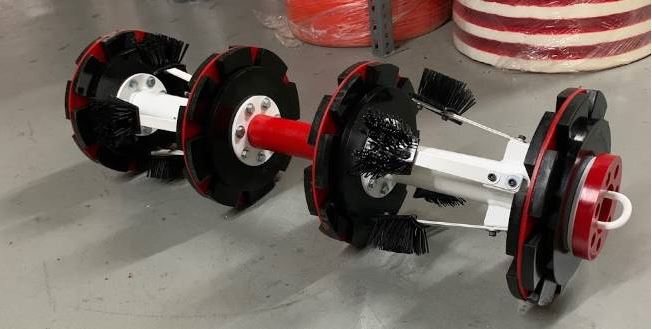 Pipeline pigging consists of using instruments called 'pigs' to undertake various cleaning, maintenance, inspection, dimensioning, process, and pipeline testing operations on new and existing pipelines. The process of pigging pipelines that are already operational is usually carried out without stopping the flow of the product through the pipeline. Polyurethane Open Cell Foam, Cast Polyurethane and Rubber are some of the materials that can be used to manufacture 'pigs'.
Pipeline pigging consists of using instruments called 'pigs' to undertake various cleaning, maintenance, inspection, dimensioning, process, and pipeline testing operations on new and existing pipelines. The process of pigging pipelines that are already operational is usually carried out without stopping the flow of the product through the pipeline. Polyurethane Open Cell Foam, Cast Polyurethane and Rubber are some of the materials that can be used to manufacture 'pigs'.
Generally speaking, pipelines are the most efficient way to transport liquids and gases across various distances. Pipelines represent a significant investment for all stakeholders, both financially and environmentally, and ongoing maintenance is vital to protect these valuable investments.
Though the reason for calling the process 'pipeline pigging' is unknown, there are some hypotheses. One theory posits that leather-bound tools were once sent through the pipeline, producing sounds similar to a squealing pig. Another theory holds that after opening a pig trap the tool lies in a pile of mud, much like a pig.
The primitive pigs of earlier applications were used exclusively to remove large deposits. Pigging schedules are an important aspect of system planning, as they occur in all phases of modern pipeline construction.
Pigging: How does it work?
Pigs will be conveyed into the pipeline when they are inserted into a Pig Launcher (or Launching Station) and flow is applied under pressure to the rear of the device. Multiply the cross-sectional area of the pig's back by the pressure applied to the rear of the pig to calculate the force applied to the pipeline by a pig.
In order to estimate differential pressure on a pig that has already entered a pipeline, the forward pressure minus the back pressure in front of the pig is subtracted. By tracking the pig at various points along the pipeline and converting its arrival time, input pressure, and flow rate into velocity, its speed can be calculated.
Pipelines that pigs traverse have large diameters on the outside relative to their internal diameters. As a result, the pig can scrape and remove debris from the pipeline. The amount and type of debris to be removed, the length of the pipeline, the number and type of pigging runs, the number and type of bends, and the frequency of cleaning pipelines determine how effective pigging is.
Pigs are caught in a Pig Catcher (also called a Receiving Station), which is isolated with a shut-off valve; they are subsequently removed safely.
However a pipeline operates, two principles must remain constant. Continuity in product flow and the minimum overall cost. Pipelines use pigs throughout their lifetime, because both of these fundamental principles are at play.
The company maintains a continuous flow of product by:
- Getting rid of damaging debris
- Preventing corrosion cell formation
- Monitoring developing issues
- Identifying potential defects
- Permitting continuous operation during lawfully required testing
Pipeline pigs also address the second principal of pipeline operation, efficiency, by:
- Getting rid of buildup
- Removing deposits that restrict flow
- Providing data for line integrity
Pigging schedules vary significantly from pipeline to pipeline. There is no one-size-fits-all pigging solution. Each pipeline must be assessed based on the unique circumstances, constraints, and variables involved.
In addition to hydrostatic testing, new pipelines must be tested after construction to ensure they will operate within the designated MAOP (Maximum Allowable Operating Pressure). During hydrostatic testing, pipeline pigs are filled with water and de-watered once the test is complete.
Pigs can also be used to clean up construction debris after a project is completed. Additionally, Pigs may also be used to further clean and dry pipelines in order to remove remaining moisture, rust, scale and debris to satisfy pipe construction codes requiring a minimum dew point.
Solutions for Pipeline Pigging & Pipe Sealing
Market leader in pipeline pigging, Drinkwater Products offers unmatched selection and all the materials needed to maintain pipelines successfully.
We have provided the oil and gas industry with best-in-class pipeline specialty products, including pipeline pigging products, since 1987. Drinkwater Products offers unsurpassed selection and all the tools needed to guarantee reliable pipeline maintenance. If you have any questions about the ordering process or order, please call 800-515-7078.
